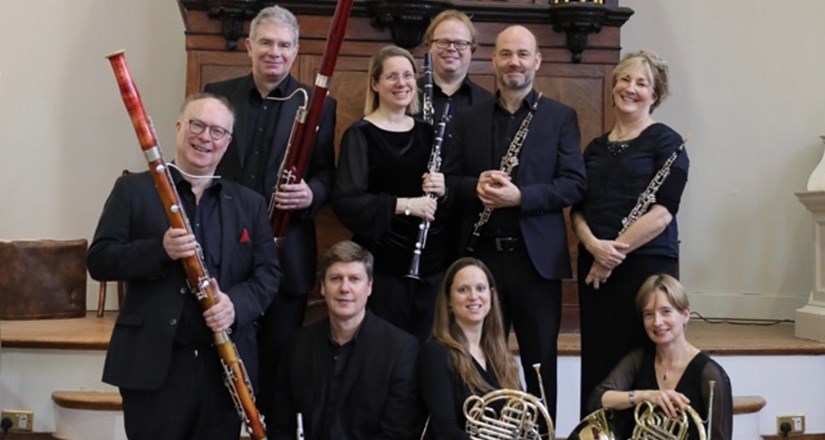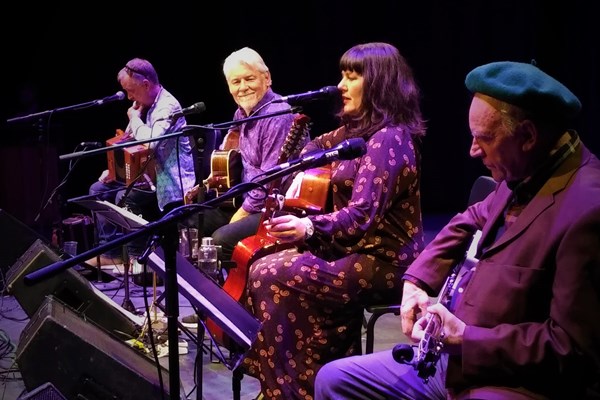
- Live Shows
- Music
- London-Serenata-Classical
A selection of our online events are free to watch and take part in. If you would like to support the work that we are doing to provide arts at home, while theatres across the country are closed, you can donate here.
Classical music returns in this beautiful recorded performance, filmed specially in the ballroom at Stamford Arts Centre.
WATCH NOW!
Watch on Facebook Watch on YouTube
Stamford Arts Centre

London Serenata
Autumn 2020
Tristan Cox oboe
Emma Feilding oboe
Julian Sperry flute
Peter Sparks clarinet
Sarah Thurlow clarinet
Jo Withers French horn
Anna Drysdale French horn
Philip Gibbon bassoon
Damian Brassington bassoon
London Serenata is a new music group formed from the Garsington Opera and Glyndebourne Opera on Tour Orchestras. Their aim is to bring all the drama and lyricism of the stage to the special intimacy of chamber music. After an acclaimed launch in October 2019, which included a sell-out concert in Oxford’s venerable Holywell Music Room, their brilliant trajectory has been sadly interrupted – as have all the Arts – by the coronavirus. They are therefore very happy to be performing again! They have tailored their programme of wind serenades to the elegance of the Ballroom at the Arts Centre, hoping to reawaken an acoustic that has been asleep for far too long.
Frederick Delius (1862 – 1934) (arr.Campbell)
La Calinda
La Calinda is an interlude from the opera Koanga which Delius completed in 1897. Koanga was inspired by Delius’s time spent in Florida and Virginia between 1884 and 1886 where his family had sent him to learn how to grow oranges! Delius’s family were wealthy wool-merchants in Bradford, and he was expected to join the family firm, but he neglected every commercial assignment he was given because he preferred to listen to and compose music. The sojourn in the orange grove was no different, and Delius spent his time vigorously pursuing his musical career.
The music of Koanga uses the African and Creole melodies and rhythms of spirituals and plantation songs, and the songs of the deck hands working on the river boats. The opera is based on the novel, The Grandissimes by George Washington Cable, and tells the story of a typical love triangle in which all three protagonists die tragically in the last scene. It is set in the American south, and promotes the idea that there is nothing wrong in a French creole servant, Palmyra, choosing to marry Koanga, an African slave, rather than the plantation overseer, Simon Perez, an American of Spanish descent.
In all his works, George Washington Cable promoted racial equality, and opposed the Jim Crow laws which enforced racial segregation. He was resented by many of his fellow Southerners, and in 1885 was forced to move his family from New Orleans to Massachusetts, due to the hostility of the Ku Klux Klan.
Wolfgang Amadeus Mozart (1756 – 1791)
Serenade No. 11 in E flat, K.375
1. Allegro maestoso 2. Menuetto 3. Adagio 4. Menuetto – Allegro 5. Allegro
This serenade was written in October 1781, after Mozart had left the employment of Prince-Archbishop Hieronymus Colloredo earlier in the year. He needed to make a living and, unencumbered by his diocesan duties, embraced every opportunity to demonstrate his powers both as a composer and as a performer.
It was rumoured that the Emperor, Joseph II, intended to form a harmonie: usually a sextet of wind players comprising pairs of horns and bassoons, and either oboes or clarinets. This was a fairly common musical grouping at this time, and many aristocratic patrons employed a harmonie to play at mealtimes and out of doors, although in Vienna itself, only Prince Schwartzenburg employed one permanently (having been gathered together in 1776).
So Mozart wrote this serenade as a sextet for horns, bassoons and clarinets, in the hope that it might be played by the Emperor’s harmonie, if one was formed. The sextet was first performed on St. Theresa’s Day, 15 October 1781, at the house of the court painter, Joseph von Hickel. As Mozart said in a letter,
“the chief reason why I composed it was in order to let Herr von Strack [the Emperor’s Chamberlain], who goes there every day, hear something of my composition; so I wrote it rather carefully. It has won great applause and on St. Theresa’s Night it was performed in three different places; for as soon as they finished playing it in one place, they were taken off somewhere else and paid to play it there”.
But Mozart’s hopes of having his music played in the Imperial Palace were later dashed. In April 1782, the Emperor did appoint a harmonie, but he broke with tradition by forming it as an octet of horns and bassoons with pairs of both oboes and clarinets. Mozart responded by adding extra parts for a pair of oboes to the serenade “with furious speed”. But even then there is no evidence that this serenade, or either of Mozart’s other two great wind serenades, K.361 in B flat Gran Partita or K.388 in C minor, was ever played in the Hofburg Palace. As Mozart later said of Herr von Strack, “these court flunkeys are never to be trusted”.
More in Live Shows...
-
The Doric String Quartet 2026

Sat 7 Mar 2026
The Doric String Quartet brings elegance and intimacy both to the Classical cano...
-
ALEX CLARKE - STAMFORD JAZZ

Fri 6 Feb 2026
As a finalist in the BBC Young Jazz Musician of the Year 2020, winner of the Ris...
-
PETERBOROUGH COMMUNITY CHORUS SPRIN...

Sat 28 Mar 2026
Join Peterborough Community Chorus with special guests (to be announced) for a j...
-
BRYAN CORBETT QUINTET - STAMFORD JA...

Fri 9 Jan 2026
Experience the unmistakable sound of Blue Note Records - raw, soulful, and swing...
-
Albion Xmas Band

Fri 19 Dec
The Albion Christmas Band are widely regarded as the premier seasonal show, which has been touring for 26 year...
-
Imogen Cooper

Sat 11 Apr 2026
Regarded as one of the finest interpreters of Classical and Romantic repertoire, Imogen Cooper is internationa...
-
Martin and Eliza Carthy

Fri 13 Mar 2026
2025 Mercury Prize Shortlisted Martin Carthy & Eliza Carthy Lifetime Achievement Award – BBC Radio 2 Folk Aw...
-
Jacqui Dankworth: The Sondheim Song...

Fri 13 Feb 2026
The internationally acclaimed vocalist Jacqui Dankworth presents her own very sp...








